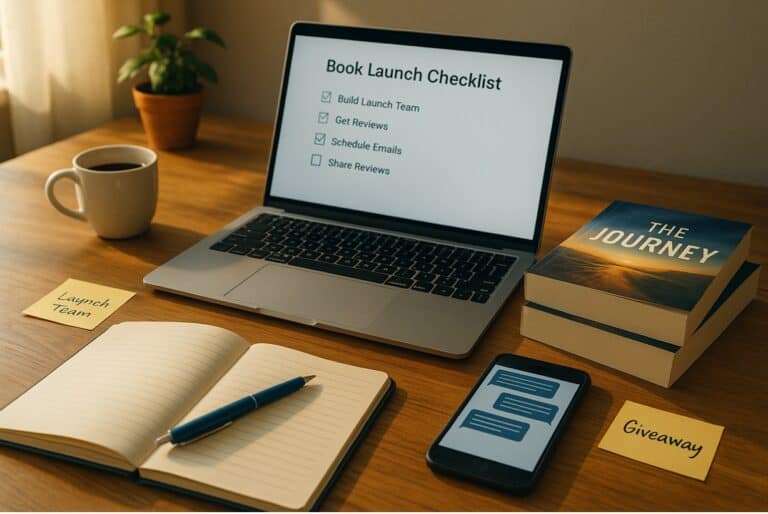The Magic of eBook Templates: 5 Tips for New Authors

Explore the power of ebook templates for new authors. Simplify your writing journey with our guide to free templates. Let our guide be the compass to finding the right template for your ebook.
“There are many little ways to enlarge your world. Love of books is the best of all.” – Jacqueline Kennedy Onassis
Are you starting your first ebook but not sure where to begin? Do you stare at a blank screen or page and sense a chill of intimidation? You’re not alone. The act of transforming thoughts into words can be daunting, especially for new authors. But here’s a secret: ebook templates. This magical tool may transform your writing journey, making it more manageable.
Welcome to our six-part series on ebook templates.
This multi-part journey is designed with a singular goal in mind. They’re intended to empower you with a solid understanding of the free templates available today. Whether you’re a first-time author, an experienced writer looking to self-publish, or a creative soul testing the waters of digital writing, this series is your gateway to creating ebooks with ease.
Each article, which is shorter than this overview, spotlights a specific platform. We take you from popular and user-friendly tools, such as Canva, to versatile options such as Google Docs and Microsoft Word. We also explore the potential of presentation software turned ebook creators like PowerPoint and Google Slides.
In every article, we unpack the unique features. We look at the advantages and potential drawbacks of each platform. We provide handy guides on how to use the templates, sprinkle in some expert tips for the best results, and share inspiring success stories.
Whether you’re in search of a free template to kick-start your journey, or you’re ready to invest in a premium option, let this series be the compass in your author journey.
Let’s get started.
Choose from a variety of free templates on platforms such as Canva, Google Docs, Microsoft Word, and more. When your masterpiece is ready, it’s a breeze to upload it to platforms like Amazon KDP. Dive into our guide to learn more about template ideas, sizes, design, and more. Your path to becoming a published author starts here.
What are eBook Templates & Why Should New Authors Use Them?
Simply put, ebook templates are pre-designed layouts or structures. Think of them as architectural plans for a house, guiding you through the building process. Templates provide a pre-designed, professional layout for your content. They typically include elements like headers, footers, page numbers, and even space for illustrations.
Why use ebook templates? Imagine trying to build a house without a blueprint. The result would probably be disorganized and confusing. The same goes for creating an ebook without a template. It provides a simple structure, ensuring your book’s interior format is organized and easily digestible. Plus, it can save you a lot of time and frustration.
The templates also come in various shapes and sizes, catering to different genres and styles. Whether you’re working on a thrilling novel or an informative guide, there’s a template size to fit your needs. Because they allow you to focus on the content itself, they’re ideal for aspiring authors.
How Do You Navigate the World of eBook Templates?
Free ebook templates? Yes, you heard it right. Many platforms provide free templates to kick-start your writing. Some are 100% free, some are free to try. They come in a variety of designs and structures, catering to different genres and styles.
Choosing the right ebook template for your genre is a key step in the process. Start by understanding the conventions of your genre. For instance, romance novels have a unique structure compared to mystery novels. Next, consider your personal style and how it aligns with various templates. Do you prefer short, concise chapters or long, detailed ones? Finally, browse through different templates and select one that resonates with you and your genre. Remember, the right one will enhance your content, not restrict it.
Here’s a quick look at some popular platforms. In our series, we go into more depth on each one.
- Canva: It’s known for its user-friendly interface. Canva offers a variety of free ebook cover templates and design templates. Their drag-and-drop feature makes it easy for authors to create professional-looking ebooks. They also have a pro version.
- Google Docs: Google Docs isn’t just a word processor. It’s also a source of free templates. These are simple and easy to use, making them perfect for first-time authors. Plus, you can collaborate with others in real-time. This makes it ideal for co-authored works.
- Google Slides: Much like PowerPoint, Google Slides isn’t just for presentations. It also offers an array of free template ideas. Plus, because it’s a cloud-based tool, you can access your work from any device.
- Microsoft Word: Don’t overlook this classic word processor. Microsoft Word provides a range of free templates. It has minimalist designs and more elaborate ones. These templates are easy to customize, making them a favorite among many new writers.
- PowerPoint: Surprised? Yes, you can use PowerPoint for more than presentations. With its easy-to-use interface, you can create visually engaging ebooks. This makes PowerPoint a great option for any ebook that can benefit from a visual-centric approach, such as children’s books, cookbooks, or travel books.
The best ebook template, of course, is the one that resonates with your ideas and your readers. So, take the time to explore these platforms and find the perfect fit for your writing journey.
When I started on my first ebook project, I was as enthusiastic as a puppy with a new toy. I paid for a sophisticated Adobe InDesign template. I was confident my tech-savvy skills would carry me through. It was sleek and professional, but absolutely bewildering.
Days turned into a blur of tutorials and coffee refills as I grappled with the myriad of design options. I felt like a novice lost in layers, text wrap, and Bézier curves. In my eagerness to create the “perfect” ebook, I jumped headfirst into the deep end of design complexity.
One day, a friend dropped by, and I shared my InDesign woes. She glanced at my screen, stifled a chuckle, and gently suggested, “Have you tried Google Docs?”
In the end, I migrated my content to the simpler, and free, Google Docs. It was a relief. So much for my grand foray into professional-grade design. I learned a lesson in humility. It was also a reminder to match my tools with my actual needs, not my imagined capabilities. Now, I can’t help but laugh at my initial overzealous misstep. Simple doesn’t mean ineffective.
How Do You Customize a Template to Make Your eBook Stand Out?
Making an ebook stand out begins with choosing the right design template. Most of them are customizable. They allow you to tweak the design and layout to fit your needs. Most of them offer the flexibility to change font style, adjust the margins, or rearrange the chapters. This means you can start with a free ebook template. Download and change it until it perfectly suits your vision.
A common mistake new authors make is sticking too rigidly to the structure. Templates guide you, not box you in. Tweak the layout to suit your story.
There is no one-size-fits-all for ebook templates. However, some sizes are commonly used. For instance, most Amazon Kindle ebooks use a size of 6″ x 9″. However, the size may vary depending on the publishing platform you’re using. Check the specific requirements of your chosen platform before finalizing the size.
Preview your ebook before publishing. Always review your work on multiple devices to ensure it looks good and reads well. Avoid overlooking the importance of a captivating ebook cover. Remember, first impressions count. A visually appealing cover can draw readers in, while a well-structured layout can enhance their reading experience.
The real key to standing out is your content. Use the template as a guide, but let your unique voice shine through. Inject personality into your writing and engage readers with compelling storytelling. After all, it’s not just about how the ebook looks. It’s about how it makes your readers feel.
The Art of Selling eBooks Made with Templates
Now, let’s address the elephant in the room. Can you sell ebooks made with templates? Absolutely. Using one doesn’t diminish the value of your work. It’s the content that matters, not the tool used to structure it. Various successful authors have used ebook outline templates and even ebook copyright ones to streamline their process. For example, Kindlepreneur offers a free copyright template.
What’s a popular platform for selling ebooks?
Once you’ve crafted the ebook, it’s time to share it with the world. A popular platform for selling ebooks is Amazon Kindle Direct Publishing (KDP). It’s often recommended for first-time authors. Besides being the biggest bookseller platform, it’s easy to use. You simply create an account and then upload the files for your manuscript and cover. After they’re uploaded, be sure to use the preview to see how the finished version will look on Amazon. After filling in the remaining details, such as keywords and categories, you can move on to pricing it and then publishing it.
Turning the Page: What’s Your Next Step?
As a first-time author, exploring the world of ebook templates can be an exciting adventure. It’s like unearthing a treasure chest of tools to make your writing process simpler, smoother, and more efficient. It can save you time and energy, which you can spend on crafting your narrative. Use a template as a guide, not rules set in cement. Tweak and adjust as needed to match your unique writing style and the specific needs of your story.
As you venture into this brave new world, remember: the magic doesn’t just lie in the tools you use. It lives in your words, your imagination, and your ability to weave a story to captivate your readers. (For techniques on engaging your readers, see Show Don’t Tell: 5 Tips to Captivate Readers).
Your Call to Action
Now, with this knowledge in mind, it’s your turn to take the leap. Don’t let the blank page intimidate you. Every talented writer starts with a blank page.
Grab a template, start typing, and let your creativity run wild. Why not try it? After all, every story deserves a strong structure. But remember, a template is just the beginning. Your unique storytelling flair will bring your ebook to life. Take the step. Download a free ebook template today and start turning your dream into a reality. Your story deserves to be told, and the world is waiting to hear it.
How can we help? To let us know, please fill out our contact form. Happy writing!
TIP: In our next article of this six-part series, we take a more detailed look at Canva’s ebook templates.


